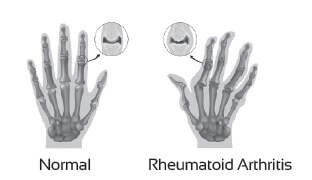Rheumatoid Arthritis - Symptoms
RA symptoms have a gradual onset in most cases. Patients notice a slow development of signs and symptoms over a period of weeks to months. The disease has an intermittent course wherein there are phases of flare-ups (when the disease activity increases) and remission phases (when the disease remains silent), making the diagnosis and treatment difficult. Again the non-specific symptoms or certain atypical presentations may further add to the problem in diagnosing this condition.
Signs and symptoms of joint affection in RA:
- One of the characteristic features of RA is symmetric involvement of joints (seen in many but not all cases)
- Polyarticular involvement - usually five or more joints are involved (this is highly variable). Over a period of time, more and more joints tend to be involved sequentially.
- Symptoms vary in severity from case to case and even from time to time in the same patient
- The disease primarily attacks the peripheral joints, which include the proximal interphalangeal joints (PIP) and metacarpophalangeal (MCP) joints of the hands, wrists, shoulders, elbows, knees, ankles, and metatarsophalangeal (MTP) joints of the feet.
- During the flare-up, the affected joints become red, swollen, painful and tender. The pain usually gets worse from movement and there is a stiffness of joints.
- Joint stiffness (and even swelling at times) is quite marked in the morning (morning stiffness) and it may last up to few hours.
- Stiffness may also be worse after periods of inactivity like sitting for a long time.
- Joint deformities may be seen in chronic cases, whereby the joints of fingers may be fixed in a certain way, giving rise to 'swan-neck deformity' or 'boutonniere deformity'.
- Low grade fever is quite common.
- Weight loss is seen in many cases of RA.
Symptoms
- Swelling in joints(specially in small joints)
- Red and puffy hands
- Joint pain(early morning siffness lasting more than one hour)
- Back pain (specially in men)
- Tightening of skin
- Skin rashes
- Weight loss

On account of the symptoms described above, simple tasks of daily living may also become difficult for RA patients. Turning door knobs, working in the kitchen, opening jars, combing hair, dressing themselves, etc., can also become quite difficult during the phase of relapse. Not being able to perform daily tasks with ease may become a cause of depression, anxiety and helplessness for these patients.
Non-articular symptoms (other than those related to joints) of RA include the following:
- Rheumatoid nodules: These are small, firm, painless bumps of the tissue under the skin and are commonly seen on arms, elbows, knees and on pressure points of the feet.
- Tingling or numbness in feet and hands due to affection of the nerves (neuropathy)
- Heart affection: Pericarditis (inflammation of the membrane that surrounds the heart)
- Lungs affections: Pulmonary nodules, pulmonary fibrosis, pleuritis (inflammation of the membrane that surrounds the lungs)
- Eye affection: Episcleritis, Scleritis (inflammation of the white part of the eyes)
- Affection of the blood vessels, especially small vessels of the fingers, leading to infarcts along the nail-beds
- Osteoporosis: Loss of calcium from the bones that makes them fragile and porous (and thereby more easily prone to fractures)


